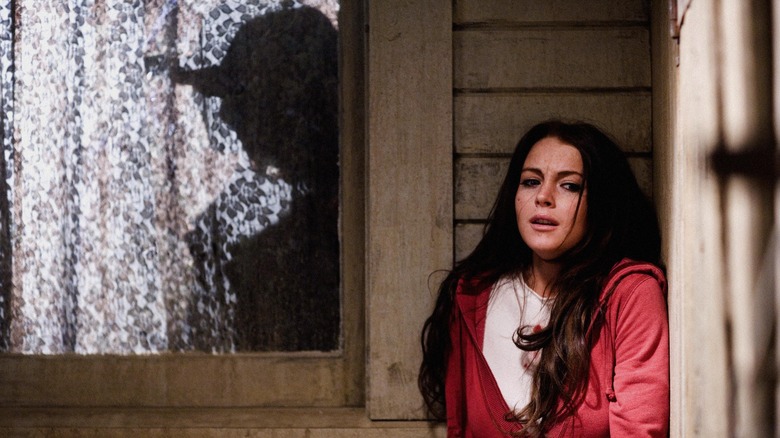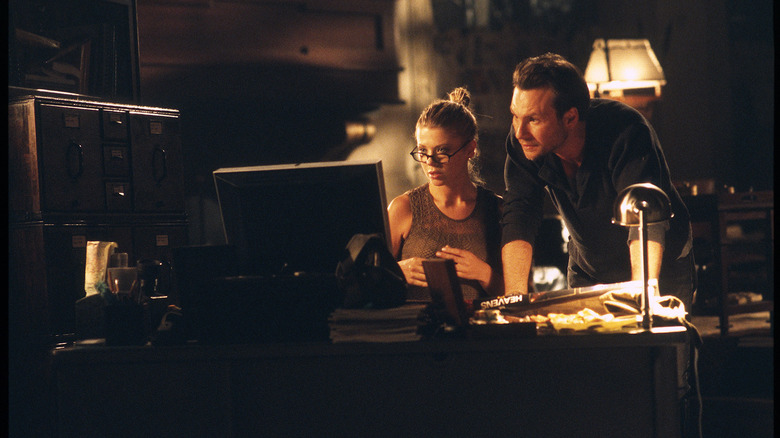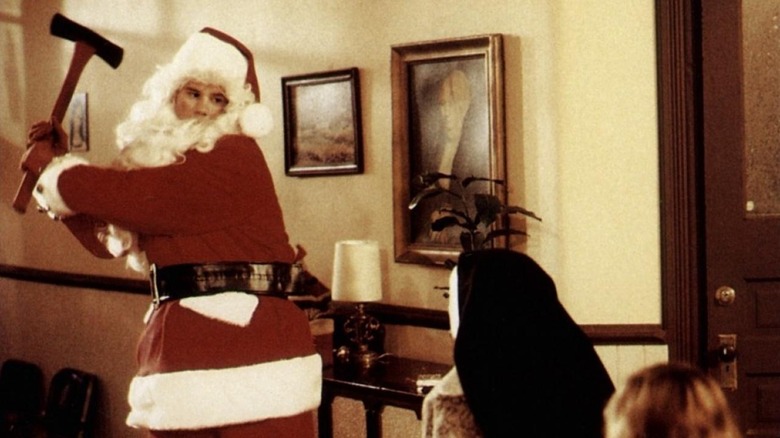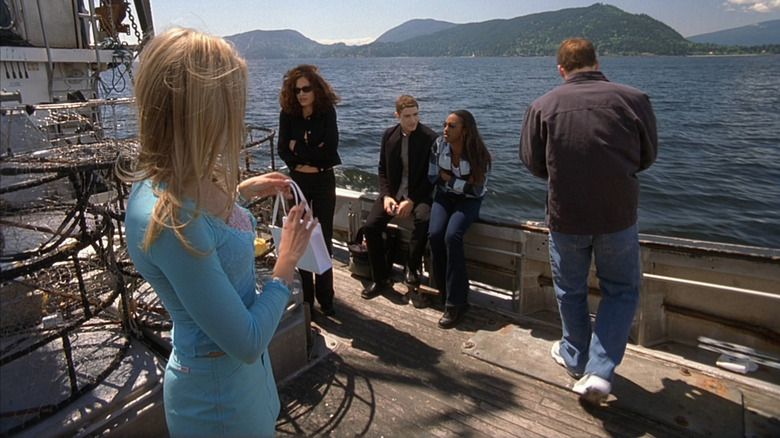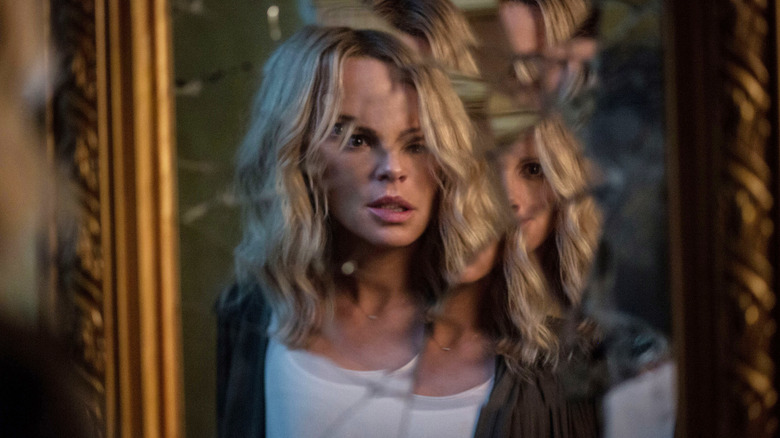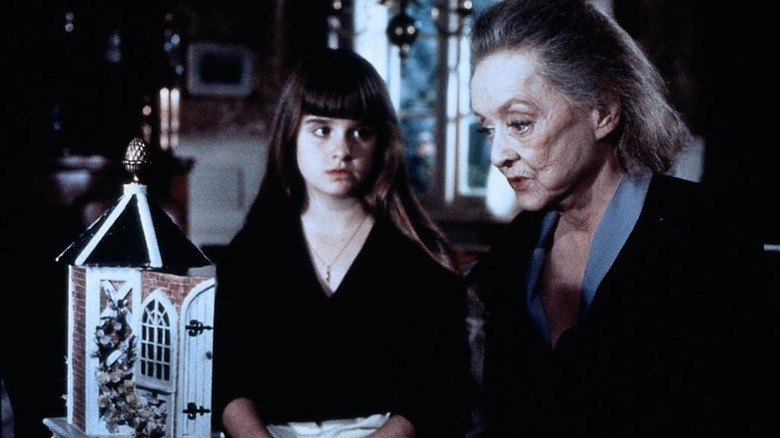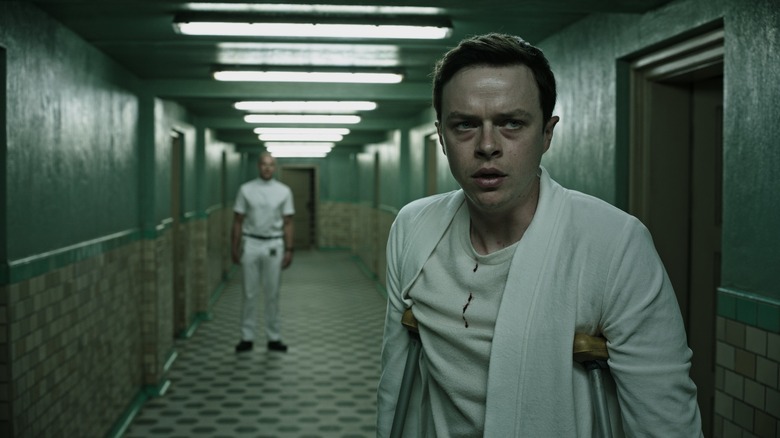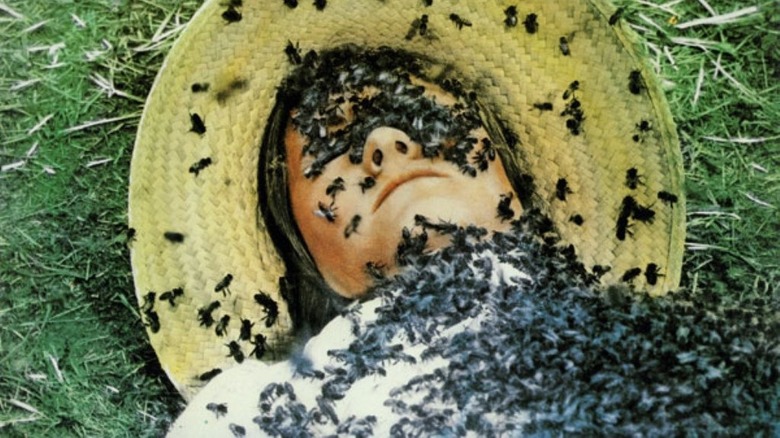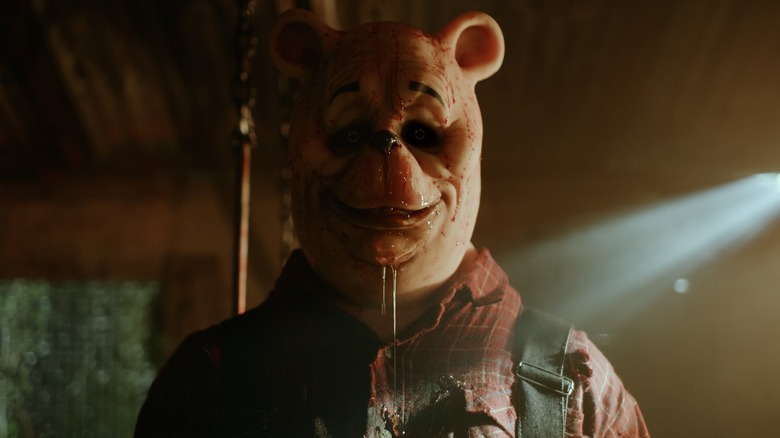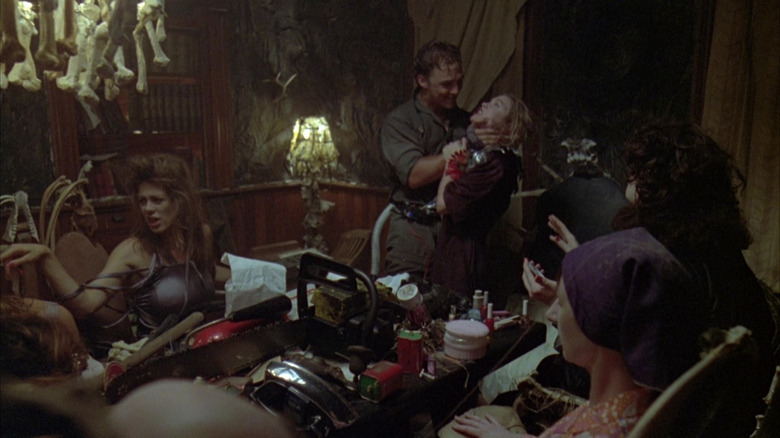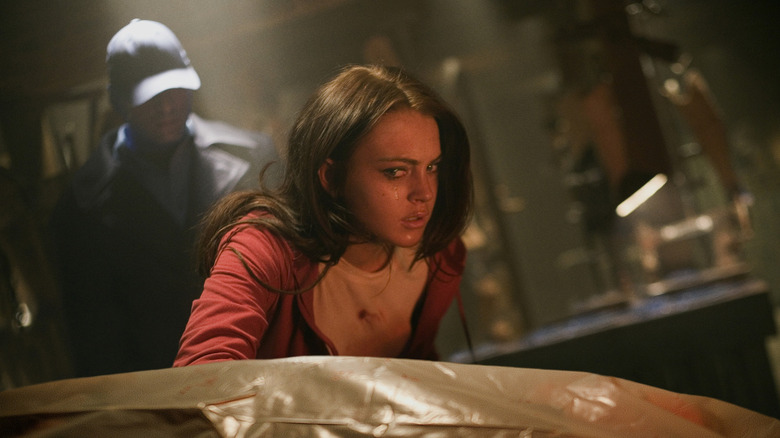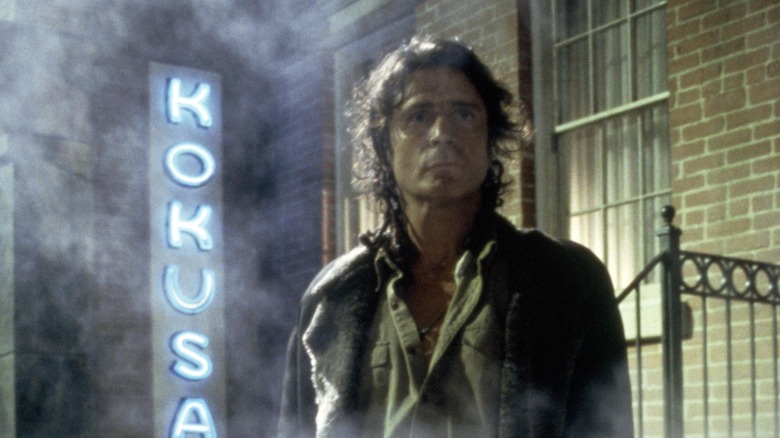Horror Movies So Bad They Were Pulled From Theaters
For every horror movie that turns into a massively profitable hit, there are plenty more that didn't light up the box office. In fact, they continue to be made with such frequency in part because their budgets are usually low enough that it's pretty easy to recoup expenses with anything other than a total disaster. Still, there are plenty of times when horror films don't perform as well as expected. Sometimes they are reassessed years after release with much more favorable results, and the horror genre is rife with box office flops that became cult classics and underrated "masterpieces."
But then you've got the true, out and out stinkers. The films that couldn't even keep up the pretense of being merely a disappointment, and led their studios to pull them from theaters prematurely in an effort not to send good money after bad. Their downfall could have been a result of controversy, expectations that were a tad too high, or — how shall we put this politely? — quality control issues. But whatever the reason, their showing at the box office was too calamitous too ignore. Here are some bad horror movies that were quickly pulled from theaters.
Alone in the Dark
Director Uwe Boll has become known for adapting video games into major film releases — but that doesn't mean that all of them are worth watching. "Alone in the Dark," for instance, was met with an incredibly negative response, and it's considered one of the worst movies in recent memory. Based on the survival horror video game of the same name originally released in 1992, this film stars Christian Slater and Tara Reid (a puzzling on-screen duo if we've ever seen one) as a paranormal investigator and his girlfriend who end up in over their heads as they face off against mysterious supernatural creatures.
"Alone in the Dark" was given a wide release in 2005, premiering in 2,124 theaters across the United States. But when it received abysmal reviews from critics (it currently holds a 1% on Rotten Tomatoes) and showed no signs of recouping its $20 million budget, distributors made the move to dump it — and fast. By its third weekend, it was showing in just 209 theaters before disappearing into the ether entirely.
Silent Night, Deadly Night
"Silent Night, Deadly Night" has a central premise that isn't exactly the most family-friendly. In it, a young Billy watches his family destroyed by a murderer dressed up as Santa Claus, develops an extreme sense of guilt and shame while growing up in a Catholic orphanage, and goes haywire as a young adult when he's triggered by the romantic relationship between his two coworkers. The end result is Billy going on a murder spree while wearing a Santa costume, an image that offended many would-be viewers.
The outrage was so extreme that widespread protests panicked its distribution company, leading them to pull ads for the film less than a week after its release. "Silent Night, Deadly Night" was to meet the same fate not long after, and it was removed from theaters, despite the fact that it had been performing surprisingly well at the box office. Protestors may have won the battle, but they lost the war — "Silent Night, Deadly Night" isn't actually all that bad, and it became an unlikely cult classic, spawning four sequels and a remake that was supposed to come out in 2022 but still hasn't climbed down the chimney.
House of the Dead
"House of the Dead" is yet another Uwe Boll stinker, starting off a Hollywood career filled with poorly received productions. Based on a horror video game of the same name, "House of the Dead" revolves around a group of college students who decide to take a boat off the coast of Seattle in search of a rave island. Good news: They find the island. Bad news: It's not so much filled with early 2000s party animals as it is bloodthirsty zombies.
The reception of "House of the Dead" was probably not what Boll had hoped for. It was eviserated by critics and failed to make much of an impression at the box office. Although it began in a respectable 1,520 theaters, by the third week it had dropped to just under 800, and within a month of its release, it was nowhere to be found at the cinema. Still, despite the apparent lack of interest in "House of the Dead" as a franchise, "House of the Dead 2" was greenlit and premiered — albeit in a direct-to-cable capacity — in 2006.
The Disappointments Room
Usually, when a movie is completed but doesn't hit theaters for two whole years, there's a reason for it. Such is the case with "The Disappointments Room," which ... well, is aptly named. Starring Kate Beckinsale as a grieving mother who moves to a creepy old mansion with her husband and surviving son, the film focuses on the dark history of the wealthy family that used to live in their new home. "The Disappointments Room" faced its fair share of troubles before it even hit theaters, bouncing between distribution houses as each went through financial difficulties and sought to offload what was presumably already considered a disaster-in-waiting.
When it was finally released in 2016, it opened in 1,554 theaters, but came in a disappointing 17th place at the box office for the week. By the third weekend, it was only showing in 36 theaters, setting a new record for films dropped by theaters in their third week. Not exactly the stuff that good old-fashioned Hollywood success stories are made of.
The Watcher in the Woods
Horror movies from the Disney corporation? Now we've seen everything! Actually, Disney's live-action films (and their animated ones, for that matter) used to come tinged with serious darkness back in the day, even if '80s creepfest "The Watcher in the Woods" may have gone a step further than most. It stars Kyle Richards and Lynn-Holly Johnson as a pair of sisters who move with their parents to an English estate, where they are haunted by a mysterious entity in the nearby forest. Bette Davis also appears in one of her last film roles as the eccentric Mrs. Eylwood, who also lives on the estate, mourning the loss of her teenage daughter decades earlier.
The film was supposed to end with a special effects sequence including an alien flying one of the girls to its spaceship, but they weren't able to put it together in time for its theatrical opening, so instead they rushed out an incomprehensible ending that probably didn't make sense, even to the people who worked on the film. The result was disastrous — "The Watcher in the Woods" was widely panned, and was pulled from theaters just 10 days after its glitzy premiere at the Ziegfeld Theater in New York.
However, unlike the original cut of "The Watcher in the Woods," this story has a happy ending. Disney spent the next 18 months re-cutting the film, eventually releasing it in late 1981. Although it still wasn't particularly well-received, it was a far cry from the complete dud they had dropped in theaters earlier.
A Cure for Wellness
It's rare that a big budget, well-promoted horror movie with an esteemed director (Gore Verbinski, returning to horror after a long hiatus) and a cast full of popular actors takes a complete nosedive, but that's what happened to "A Cure for Wellness." Although its intriguing trailer had grabbed the attention of audiences, poor word of mouth and negative critical reviews made it clear that this Dane DeHaan-led psychological horror wasn't going to be the hit they had all hoped for.
Perhaps because "A Cure for Wellness" was meant to be a prestige horror project, its studio was less willing to let it languish in theaters than it would have for your run-of-the-mill slasher. They wanted to put this ambitious failure to bed and hope everyone would forget about it. As a result, although it opened to a robust 2,704 theaters across the country, after its second weekend, that number had dropped to a paltry 88 (which, interestingly enough, stole the record of biggest third week drop once held by "The Disappointments Room").
The Swarm
When "The Swarm" was preparing to hit theaters back in 1978, Warner Bros. had every reason to believe that it would be a hit. It was part of the then-popular disaster movie craze (albeit one with more of a focus on wildlife than natural phenomena), and it had the aging superstar cast to match. "The Swarm" starred Michael Caine, Fred MacMurray, Olivia de Havilland, Henry Fonda, Richard Chamberlain, and Katharine Ross, to name just a few. Warner Bros. had also invested heavily in the production, giving it a budget of $21 million (just over $100 million today), which is a lot, considering that horror movies are often greenlit precisely because they can be made on the cheap.
In the end, that budget may have been the death knell of "The Swarm." Sure, it performed poorly, it angered the beekeeping community, and most moviegoers didn't seem to think it was very good. But with that kind of pricetag attached to it, "The Swarm" had a massive uphill battle to turn a profit. The poor thing didn't stand a chance. It crashed and burned at the box office and was reportedly pulled from theaters after just two weeks.
Winnie-the-Pooh: Blood and Honey
"Winnie-the-Pooh: Blood and Honey" isn't exactly a shining example of what happens when a beloved literary character enters the public domain. The gruesome thriller showcases a version of the Hundred Acre Wood where its inhabitants have gone completely feral — a far cry from the docile animals of A.A. Milne's imagination. Originally, "Winnie-the-Pooh: Blood and Honey" was set to be released in theaters for a one night only as a Fathom Events exclusive. But after millions watched the trailer and word of mouth grew around the bizarre horror film, its producers began to sense an opportunity.
Invigorated by its perceived potential to go viral, they got a little cocky, and decided to release "Winnie-the-Pooh: Blood and Honey" in theaters for an extended run of 10 days. But as they learned — and as the distributors of "Morbius" learned as well — online virality does not necessarily translate to butts in seats. Although the intention had always been to pull the film from theaters after that 10-day run, if it had performed well, there's a high chance that they would have doubled-down and extended the run again. Alas, poor reviews and mediocre box office returns torpedoed any chance of that. However, it didn't stop them from greenlighting a sequel and an entire universe of twisted takes on beloved childhood characters in the public domain.
The Texas Chainsaw Massacre: The Next Generation
Looking back, it's wild to think that two widely acclaimed, Oscar-winning actors — Matthew McConaughey and Renee Zellweger, early in their careers — both appeared in a bargain basement, creatively bankrupt sequel to the influential classic "The Texas Chain Saw Massacre." But it absolutely happened, as much as everyone involved would probably want us to forget it.
Released in 1995, "Texas Chainsaw Massacre: The Next Generation" (alternately titled "The Return of the Texas Chainsaw Massacre") sees a group of high school students fresh from their senior prom do battle with both Leatherface himself and Vilmer (McConaughey), a member of the Leatherface clan. It may not come as a surprise to you that this fourth entry into the "Texas Chainsaw Massacre" universe was not beloved by audiences, and it was granted just a two-week stay in theaters, making it the worst-performing film of the franchise.
I Know Who Killed Me
Looking back, "I Know Who Killed Me" probably represents the death knell for the first act of Lindsay Lohan's Hollywood career. Starring Lohan as Aubrey Fleming, a young writer who is kidnapped and tortured by a serial killer, the film features a convoluted journey involving mysterious long-lost twins, telepathy, and plenty of secrets that only serve to complicate the plot. The film on its own is kind of ridiculous, but its reception wasn't helped by the fact that Lindsay Lohan was in the midst of significant, extremely public drug issues while it was being promoted, drawing the kind of negative attention and ridicule that always seemed to follow young actresses in crisis during the early 2000s.
"I Know Who Killed Me" opened in 1,320 theaters, but it failed to make an impact at the box office and was down to just 65 theaters by its fourth weekend. However, much like its leading lady, it has experienced a critical reevaluation in recent years, with many now considering it an impressive midnight movie in its own right.
Lawnmower Man 2: Beyond Cyberspace
"Lawnmower Man" had been a surprise hit when it was released in 1992, so the idea of creating a sequel was pretty much baked-in from the start. There was only one problem: They couldn't secure the talents of either the original film's director, Brett Leonard, or star Pierce Brosnan, who was a huge part of the film's success. Undeterred, they moved forward with the follow-up film anyway, creating "Lawnmower Man 2: Beyond Cyberspace," which was ... somewhat less inspired than its predecessor.
To say that "Lawnmower Man 2" was poorly received is a bit of an understatement. It was released in January 1996 — a time of year traditionally regarded as the dumping zone for every studio's presumed duds — to lackluster reviews, and it was pulled from theaters after just two weeks. With goofy special effects and an extremely dated storyline with '90s technofear at its heart, it's unlikely that this one will develop a late-breaking cult following anytime soon.
